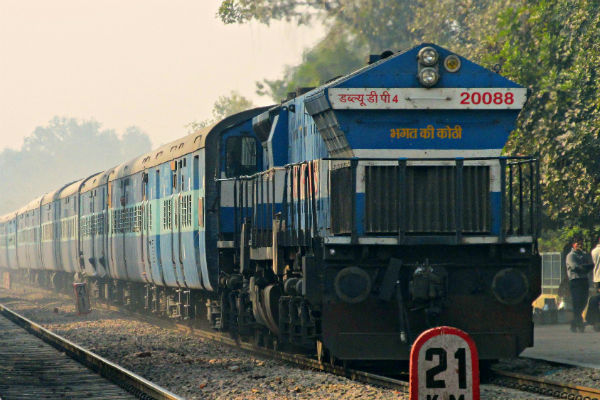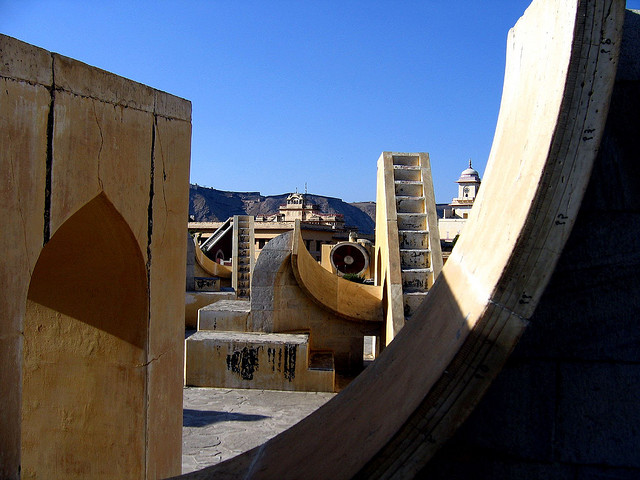Rajasthan, “The Land of Kings”, is India’s largest state by area: anyone wishing to see the full breadth of its wonders must resign themselves to days and nights of travel. In this, they are lucky. For there are few things in India to rival the experience of travel on the country’s trains.

Malani Express (Photo: Akshay gupta via Flickr)
By sunrise, the Ahmedabad-Udaipur Express is deep into the Aravalli range. These are some of the oldest mountains in India, all rock and parched shrub; in the early light they have an orange hue. The train winds its way slowly around hill faces and through cuttings in the ancient landscape. Despite its name, this express is in no hurry; our average speed on this journey will not be more than 30 kilometers per hour.
From my bunk, the view is part obscured and my fellow passengers are either still asleep, or look in no mood for conversation. I get up and walk to the partition between carriages. This was locked during the night but is open now, as are the carriage doors themselves. I hang out of one to see more — nobody is there to stop you from doing this in India. I look up toward the slow moving locomotive, and at the copper-brown carriages snaking about the metre gauge track. Udaipur is not far ahead.
The landscape grows greener as the train nears the city. This is no surprise: Udaipur is the home to five major lakes, by some it is referred to as the Venice of the East. The comparison is not misleading. As well being a city with an identity part-defined by water, Udaipur is a place of narrow lanes, stunning architecture, and magic. There are also elephants.
There is no way to describe the town’s famous Lake Palace — adrift between earth and sky at the centre of Lake Pichola — as possessing anything other than a storybook quality. The best views of it are from Udaipur’s countless rooftop restaurants and cafes, preferably at sunset, sipping at a lassi of your choice, with one eye on the James Bond film Occtopussy, which was partly shot in Udaipur in the 1980s and has since been shown in almost all the city’s eateries, every single night.

Lake Palace, Udaipur (Photo: Peter Barker via Flickr)
To call Rajasthan a land of contrasts is brazen understatement. It is not only that the state’s landscape varies so dramatically, nor just that wealth and poverty are each so frequently visible in both their extremes; Rajasthan is a place where five centuries of history seem to be occurring simultaneously, rubbing against the breathless growth of modern India.
Here is where, for many years, the Rajputs mounted a fierce defence against Mughal invaders from the North. Today, the legacy of wealth and war is everywhere, from the state’s grand palaces to its ethnic diversity.
The major cities of Rajasthan each have their own distinct feel and character, and boast unique architectural achievements. Even the dominant colours of the cities differ: Udaipur is white, Jaipur pink, Johdpur blue, Jaisalmer gold. To see one of these towns is, categorically, not to see them all — hence the need for travel.
The Indian rail network is as monumental an achievement as even the greatest heights of Mughal architecture, and, likewise, has a timeless quality. It was founded in 1853, and one could almost believe that there are trains from every decade of its existence still running.
The reality may not be quite so extreme, but it is true that some very old locomotives still ply Rajasthan’s rails. Of these, The Fairy Queen is the most ancient. This steam train was built in 1855, carried troops during the Indian Rebellion of 1857, and was restored in 1997 to haul tourists between New Delhi and Alwar, “The Gateway to Rajasthan”. At the modern end of the spectrum are a number of WiFi boasting express services that link India’s major towns. Between these two poles there lies a spice-box of locomotive variation. With over 115,000 kilometers of track, spread like a motherboard across the country, total modernisation could never happen overnight.
*** ***
Late into my journey from Udaipur to Jaipur, night has fallen, inking the outside an impenetrable black. My attention turns inside the train. I am travelling “unreversed sitting” class on the Anaya Express, which runs all the way to Kolkata. With an average speed of just over 55 kilometers per hour, this train is classified as superfast. Things onboard are basic, but not uncomfortable: the hard chairs are arranged facing each other, rows of fans line the ceiling, and there are iron bars instead of glass covering the carriage windows.
Because we are nearing Jaipur, people are returning to their assigned seats. A group of women fill the carriage around me. They are of various ages, and all wearing brightly coloured saris, many have henna designs painted on their skin; one of them in particular appears to have been painted head-to-toe in the resin. So many intricate, interlacing patterns make her look like a work of art.
One of the women sees me looking, and she begins to explain how they are on their way to a wedding ceremony. The woman wearing the most henna, she tells me, is the bride to be. The practice is about good luck and good energy; here in Rajasthan, the groom will be similarly painted. I begin asking questions, and soon the whole group are laughing around me; a tube of henna is produced, and I am asked if I want anything drawn on my skin. The movement of the train defies the possibility for elaborate patterns, so, rather egotistically, the only thing I can think to ask for is my own name.
Jaipur has a very different romance to Udaipur. There is stunning architecture here too, but there is also the full intensity of an Indian city: so much is dust and heat and noise. The tourist sites (of which there are many), seem more incidental, less dominant. The honeycomb structure of the Palace of the Winds — designed for Royal concubines in the 19th Century — is smaller than I had expected. While the Royal Observatory is as beautiful as it is unsettling: full of odd geometric constructions that seem devoid of practicality: many have a half-finished quality that speaks of the futility inherent in humanity’s desire to really know the stars.

The Royal Observatory in Jaipur’s Pink City (Photo: N. Nelson via Flickr)
With eleven official different categories of train, ten different classes to chose from (“First Class AC” at the top end to “Unreserved” at the bottom), and an official nationwide time-table booklet the size of a heavy novel, travel on Indian Railways can seem intimidating. Particularly when you add to this stations that feel more like temples to anarchy than serviceable transport hubs: forget orderly queues or intelligible schedule announcements, instead, expect the constant cry of chai wallahs, the bustle of men hoping to carry your bag, and the occasional cow, ruminating near, or even on the tracks.
And yet behind these scenes, however, there runs an efficient machine; it is a triumph of bureaucracy. The key to navigating it is several fold. First, keep a clear head — the system is there to be used, and it does work: 8 billion passengers a year can’t be wrong. Second, learn the ropes! Figuring out the booking systems can feel a bit like learning a new language, but there are plenty of travel guides and websites to help you.
A good place to start is The Man in Seat 61, this site offers information on the logistics of travel the world over, and its section on Indian train travel is typically clarifying. Familiarising yourself with the Indian Railways website is also a good idea. The key is to persevere: learning your 3Es from your CCs, or your Expresses from your Garib Raths offers a whole level of satisfaction of its own.
*** ***
The Malani Express left Jaipur on the stroke of midnight. Colloquially known as the Desert Queen, this train runs all the way from Delhi to one of the exotic distant edges of India: the desert fort town, Jaisalmer.
I wake to the thin red line of sunrise spreading slow across a flat horizon. For a long time there is nothing else to do, nothing else that I would want to do, but watch the great expanse of the Thar Desert being bleached by the day. There are no dunes, only thirsty plants and more dust; and the occasional cluster of huts, looking impossibly alone.
Turning my attention inside, I begin talking to a Sikh gentleman sat on the opposite bunk. He is dressed in white and has a dark blue turban. He is so neatly turned out it is almost impossible to believe that he has just spent the night on the train. He tells me he is in the army, that he had been posted in Kashmir until recently; and now he is on his way to see a friend.
He has had postings all over India. I ask him about his favourite places. He likes the desert, he says; he is bored of the mountains. What he really likes is travelling on the country’s trains: “All of India is on board.”
After about an hour’s conversation, punctuated by stops in lonely stations and taking turns to observe the desert view, another man appears at the entrance to our berth. He shakes his head side-to-side, and offers over two paper plates, on which are what look like hash browns, and sauce.
“Breakfast,” my Sikh friend tells me. “I ordered it for you at the last station. I hope you don’t mind.”
I smile and thank him, taking the food. It is greasy, spicy, and totally delicious: everything is better on a train.